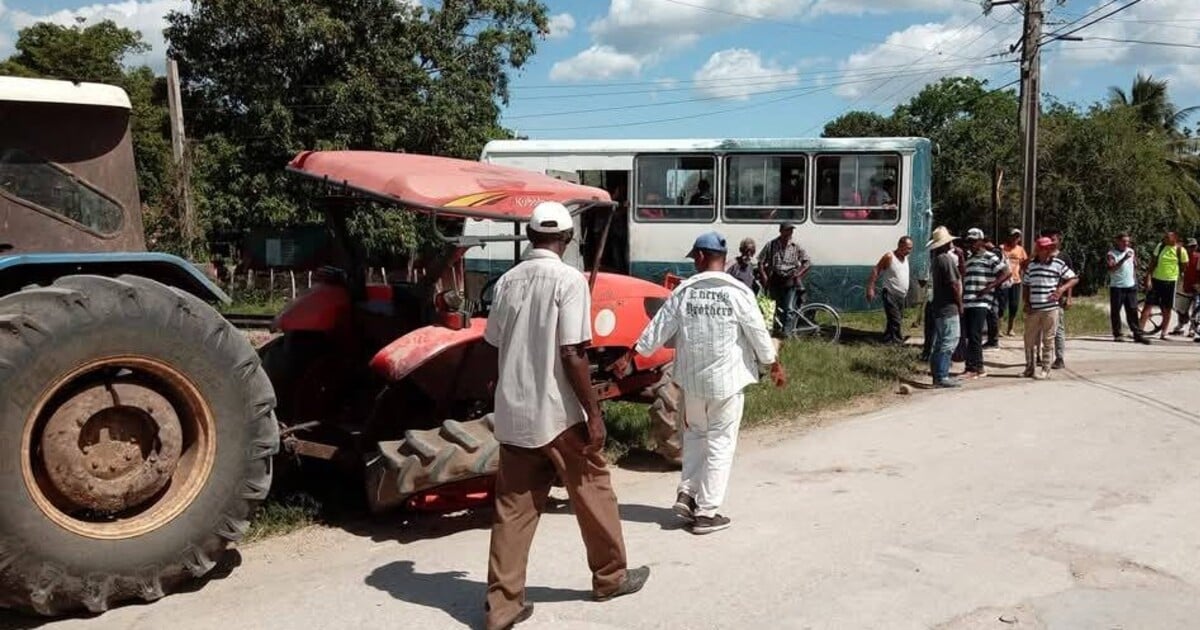On Saturday morning, another railbus accident in Las Tunas stirred concern among the eastern Cuban communities. This incident took place in Amancio municipality at the Guita bridge level crossing, where railbus number 124, traveling toward the Las Pulgas community, collided with a tractor from the Grain Company. While no injuries were reported, the accident temporarily halted rail traffic, prompting local authorities to assess the situation and organize efforts to resume service.
The event was shared on the Facebook group "Revolico Amancio" by a user known as Pollo x Pescado, sparking discussions about yet another accident involving a railbus—improvised vehicles adapted from old buses for railroad use, and often the only transportation available in many rural areas of Cuba. Although the specifics of the crash remain undisclosed, comments suggest that the railbus had the right of way.
"Thank God nothing happened, but it disrupted rail traffic, which is a big deal with all the trains and sugarcane machines passing through," remarked a local resident. "No offense, but that operator doesn't know how to handle Stop signs or crossings," criticized another user. "That location is very visible from a distance, and such encounters are rare. The railbus should have priority because of its nature," pointed out another commenter. "Tractors speed around heedlessly, ignoring traffic signs," added a third. "It was a frightening moment, but thankfully there were no serious consequences," recalled another user.
A Pattern of Repeated Incidents
These accidents are not isolated events. In February, a railbus derailed in Palma Soriano, Santiago de Cuba, injuring nine, some with fractures, though none seriously. The vehicle overturned, and the injured were transported to the nearest clinic by truck.
"It's sad that no one considers the terrible condition of these ancient vehicles and the poor state of the tracks they run on," lamented a local resident at the time. In previous years, similar incidents were reported: in 2022, a derailment in Holguín was blamed on track conditions; and in 2023, another railbus in Palma Soriano crashed into a trailer whose driver ignored a Stop sign.
An Improvised "Solution" Amidst Crisis
The Cuban government has introduced railbuses—also dubbed 'caratas'—as an emergency response to the nationwide transportation collapse. These vehicles are converted from decommissioned buses, equipped with metal wheels and guards to travel on rails. In certain provinces, authorities have even attached trailers to transport goods, including basic food supplies and agricultural products, to remote communities.
This measure, rather than being applauded, is criticized by residents as a symbol of the crumbling public transportation infrastructure and the dire living conditions faced by thousands of Cubans in rural areas. "Sadly, it takes incidents like these that impact us so much for someone to take notice of our plight," a Palma Soriano resident expressed on social media.
Meanwhile, accidents like the one involving railbus number 124 in Amancio not only highlight a pattern of continual risk but also underscore the neglect faced by many communities in the country, where mobility relies on recycled vehicles, dilapidated tracks, and alarming institutional apathy.
Cuban Rural Transport: Frequently Asked Questions
What is a railbus in Cuba?
A railbus in Cuba is an old bus that has been modified to run on railway tracks, often used as a makeshift solution for transportation in rural areas.
Why are railbuses used in Cuba?
Railbuses are used as an emergency measure due to the collapse of Cuba's national transportation system. They provide essential connectivity in areas where traditional transportation is unavailable.
What causes railbus accidents in Cuba?
Railbus accidents in Cuba are often caused by the poor condition of the vehicles and tracks, as well as the lack of adherence to traffic signals by other vehicles.
